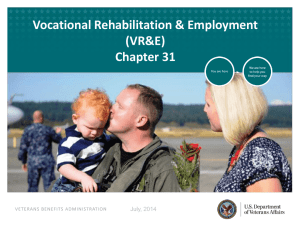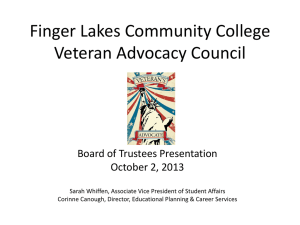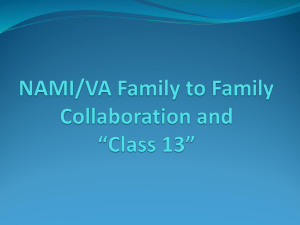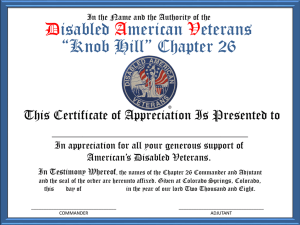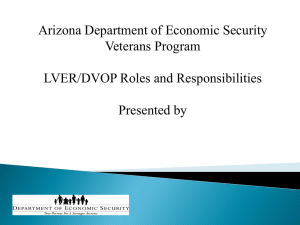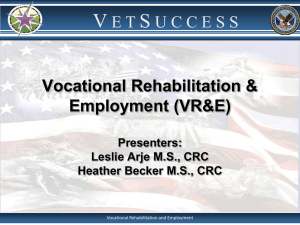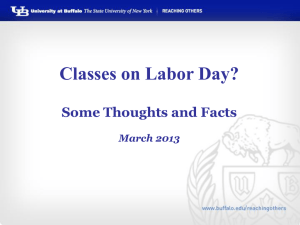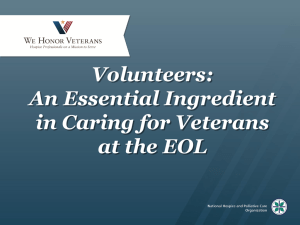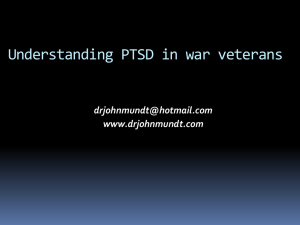Veterans Issues at the End of Life
advertisement
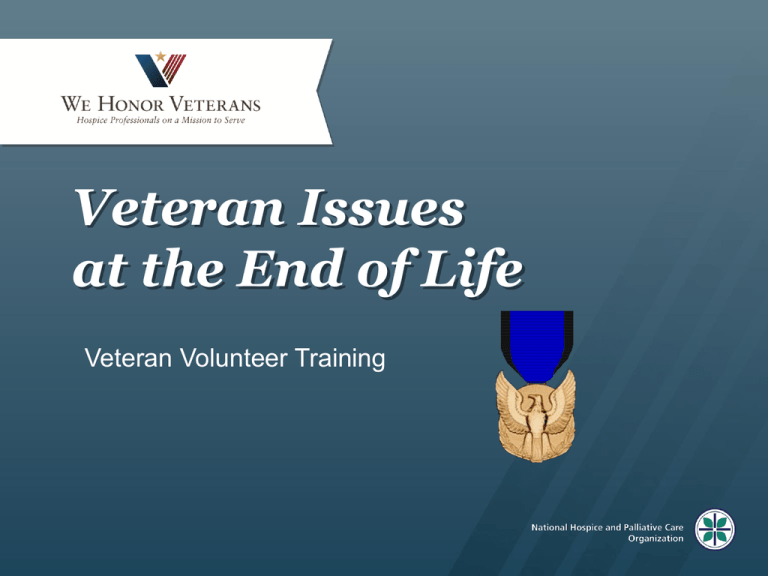
Veteran Issues at the End of Life Veteran Volunteer Training Objectives of Training At the end of the training, the volunteer will be able to: • Describe why it is important to improve our knowledge and understanding of Veteran’s needs • Describe how we can best meet the needs of Veterans and their loved ones • List four unique issues that Veterans may face at the end of life US Veterans – The Facts • • • • 26 million Veterans are alive today 25% of all deaths in the US are Veterans More than 1,800 Veterans die each day The VA cares for a minority of Veterans at the end of life: 96% die in the community. • Only 33% of Veterans are enrolled in the VA to receive benefits. Veteran’s Unique Needs America’s veterans and their loved ones may have unique needs These needs may be influenced by: • Combat or non-combat experience • Which war they served in • If they were POW’s • If they had/have PTSD • The branch of service and their rank • Whether they were enlisted or drafted Veteran Volunteers who work with Veterans in Hospice • Bring their military training and history to their hospice work • Offer unique opportunities that support life review and healing • Are able to share a common language • Share a cultural bond that opens doors of trust • Share codes of conduct and honor • May facilitate dissolving the barriers of stoicism and secrecy often found with Veterans (especially those with combat experiences) War Experience • • • • • • World War II Korean Conflict Vietnam War Gulf War Other conflicts around the world Peacetime War’s Consequences “The outcome of any armed conflict holds not just the promise of peace but also dark, terrible revelations, questions of justice over the vanquished, and, for far too many, the confronting of personal loss.” Veterans History Project: Forever a Soldier: Unforgettable Stories of Wartime Service Military Cultural Norms Influences on end-of-life experience... • Promotion of stoicism • Fear and admitting pain seen as a sign of weakness – – – – “Big boys don’t cry” “No pain no gain” “Few good men” “Once a Marine always a Marine” Possible Outcomes from Combat Experience Some are able to integrate experience into their lives, especially if they… • are naturally resilient • have good family and social support • had a positive war outcome • talked about their war experiences Post Traumatic Growth Symptoms • • • • • Relating to others Open to new possibilities Personal strength Spiritual changes Appreciation of life Traumatic Combat Memories Can Cause: • • • • • • Alcohol/drug abuse Social isolation Anxieties Anger outbursts Difficulty concentrating Post-Traumatic Stress Disorder (PTSD) Post Traumatic Stress Disorder (PTSD) • Exposure to a traumatic event • Persistently re-experienced through: – Recollections/flashbacks – Nightmares – Sensory distress cues • Individual persistently avoids associated traumatic stimuli – Thoughts, feelings, conversations about trauma – Situations that trigger sensory distress cues • Other persistent symptoms Post Traumatic Stress Disorder (PTSD) • The onset of PTSD can be acute, chronic, or delayed • How it will manifest, who it will affect is unpredictable • Immediate treatment and ongoing support helps Types of Response to War Trauma Three responses to war trauma: • Integrated Response to Trauma – Trauma has been processed – Healing occurs- life goes on • Incomplete Integration of Trauma – PTSD is prolonged • Apparent Integration of trauma – Trauma is kept in the unconscious and everything seems to go on – Lingering effects of war trauma – Undiagnosed/ delayed onset -Deborah Grassman, VA Hospice, Bay Pines, FL Integrated Response to Trauma “I’ve faced death before…I’m not afraid anymore...I’m not afraid now.” “I’ve faced death before and survived…Every day since then has been a gift.” It’s important to: • Listen carefully • Invite them to tell their stories • Express appreciation for their service to our country, and • Celebrate their accomplishments with them • Affirm the wisdom they have gained and let it impact your life Incomplete Integrated Response to Trauma “I lost my soul in Vietnam.” “If I’d just …..he’d still be here today.” “Most of my brother stayed over there.” “My son’s never been the same.” “I didn’t know the person who came back to me.” Indications of a Veteran with incomplete integrated trauma include: • PTSD • History of alcohol and/or drug abuse • Estranged relationships • Unfulfilled longings • Suspicion & lack of trust • Anxiety and agitation or acting out of the trauma • Nightmares • Sleeping “on guard” How to Respond to Incompletely Integrated Trauma • Remember that their behavior is related to trauma • Offer statements such as, “Some Veterans tell me they experienced some horrific things in war. Did anything like that happen with you?” • After a question about war, sit quietly • Some medications may help • Don’t touch unexpectedly. Call their name first. • Realize that noxious stimuli can re-stimulate trauma • Assess for environmental triggers As a Veteran… • You may offer camaraderie • Keep the focus on the Veteran patient, not yourself • Remember the Veteran’s experience may be different than yours • Open the door but never push Responding to Guilt • Combat veterans may feel guilty about acts committed during war. • Statements to avoid? • Creating safe emotional space through listening Apparent Integration of Trauma “I don’t want to talk about it.” “What good will it do anyway?.” Indicators that a Veteran may have Apparent Integration of Trauma include: • Acting out behaviors • Workaholic or other addictive behaviors • “White Knuckle Syndrome”-Veteran appears hollow or aloof These Veterans should receive the same interventions and care as for Veterans with Incomplete Integrated Trauma. Recommended Interventions with All Veterans • Make the environment emotionally safe • Affirm feeling aspect of their conversation • Remember that stoicism might interfere with acknowledging physical, emotional or spiritual pain Recommended Interventions with All Veterans • Recognize women Veterans: – – – – Military nurses saw trauma/mutilation Thank older women Veterans for paving the way Look for PTSD in women May have been sexually assaulted in military Remember • Non-combat veterans may have served on dangerous assignments • Combat veterans may have served in “safe” areas • Avoid making assumptions • Not all people who have suffered trauma will experience PTSD Replacing Lost Medals Volunteer: • Contacts agencies that replace lost or stolen medals • Coordinates the replacements of the medals • Note: Directions on how to obtain medals can be found online at the National Archives website: http://www.archives.gov Reminiscing/ Life Story Telling Volunteer: • Visits and listens as patient reminisces • Could record or videotape patient’s life story • Could produce a Memory Book Range of Volunteer Services • • • • • Provide transportation Provide regular volunteer visits Provide telephone assurance calls Respite for family members/ caregivers Provide education about/ assistance with Veteran Benefits Veteran’s Day Volunteer • Visits Veterans on Veterans Day in homes, nursing facilities, assisted living facilities or hospitals • Could assist LTCF’s and ALF’s in celebrating Veterans Day/ Memorial Day • Volunteers who are Veterans might wear their uniform and take part in the service • Provide hospice education to Veteran’s groups In Closing

